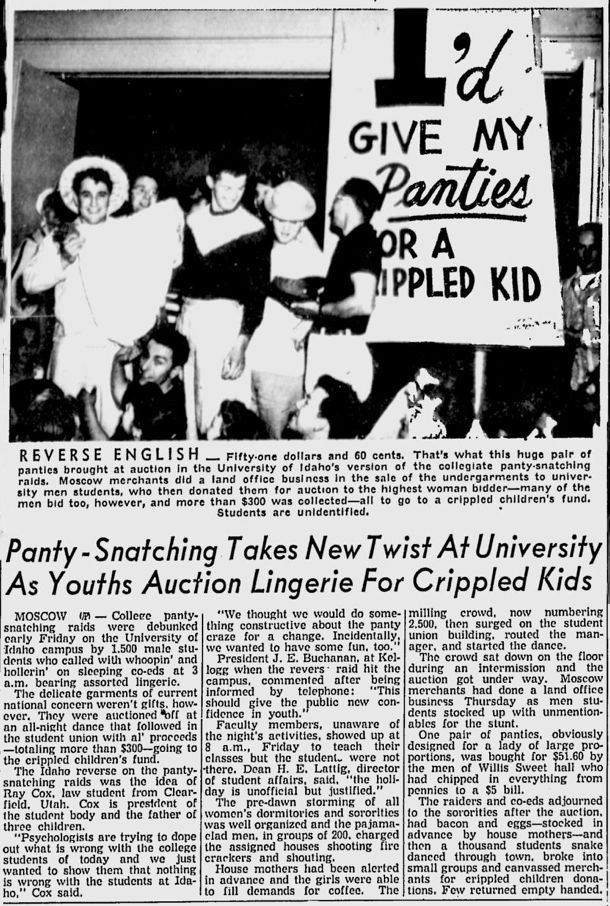Category:
Charities and Philanthropy
Charities and Philanthropy
Taser Raffle

The town of Van Meter, Iowa is holding a raffle to benefit the police department. Each $5 ticket buys a chance to taser either the city Administrator or a city Councilman. The money is going for new equipment, like tasers.
Posted By: Alex - Wed Jul 08, 2015 -
Comments (5)
Category: Awards, Prizes, Competitions and Contests, Charities and Philanthropy, Pain, Self-inflicted and Otherwise
The Man Who Owned the Salvation Army
The Salvation Army was founded by William Booth, a dedicated altruistic soul who ran it until his death in 1912.But he also had to be a canny businessman, and in 1878 he had the entire holdings of the enterprise put into his name as sole proprietor.

That paragraph above comes from this Australian newspaper, which state that at time of Booth's death the Australian holdings alone amounted to "over half a million pounds."
I find the figure of £975,000 for worldwide holdings from this 1912 biography of Booth. An online inflation calculator for British pounds figures that sum equals £81,700,000.00 today.
So the selfless General was a multimillionaire when he was Promoted to Glory and passed on the Sally to his son Bramwell.
I can't find any data on when the Booth family gave over control of the Army to some kind of board of directors. I assume they did. Did they?
Does any WU-vie have the answer?
Posted By: Paul - Mon Sep 23, 2013 -
Comments (17)
Category: Charities and Philanthropy, Money, 1910s
I’d Give My Panties for a Crippled Kid

1952 was the year that the panty raid craze hit campuses across America. One of the primary goals of the raids was to cause chaos and commotion (and grab panties, of course), but a few students at the University of Idaho decided to use the raids to achieve a greater social good. They conducted a "reverse" panty-raid. This involved showing up, "whoopin' and hollerin," in the middle of the night at a female dormitory, and then they auctioned off panties to the girls, instead of stealing panties from them. They donated all the proceeds of the auction to the Crippled Children's Fund. It was a nice gesture, but the slogan they chose for the event, "I'd Give My Panties for a Crippled Kid," probably wouldn't pass muster with the guardians of political correctness on campuses today.
Posted By: Alex - Sat Sep 29, 2012 -
Comments (4)
Category: Charities and Philanthropy, Fads, 1950s
Alec Baldwin Wants to Destroy NPR
A very funny and twisted way to raise funds, from WQXR.
Posted By: Paul - Sat Oct 23, 2010 -
Comments (10)
Category: Celebrities, Charities and Philanthropy, Radio
Weird Science – Watch and Learn

Outside it is not much to look at, little more than a discoloured rock dredged up from the sea floor. But an x-ray scan of the object, actually a pocket watch recovered from a 17th century shipwreck, has revealed that the internal mechanism has been perfectly preserved. The computer aided tomography system used was sensitive enough to pick out the tiniest details, included the engraved name of the master watchmaker, one Niccholas Higginson of Westminster, London (Gizmodo).
As if more proof were needed that they don’t build them like they used to, a UK group has started collecting donations to build the first fully working version of Babbage’s “Analytical Engine”. The original design, dating from 1837, was never completed, possibly due to a combination of the strict engineering tolerances needed and Babbage’s notoriously prickly temperament. If the final machine works as advertised, it will be very strong confirmation of the claim that Babbage designed the first general purpose, programmable computer (BBC News).
Meanwhile, in Slovenia, Borut Povse and his team are busy teaching a modern descendant of Babbage’s design to hit people. Somehow Povse has convinced six volunteers to let an industrial robot hit them on the arm with various sharp or blunt implements in an effort to determine how much pain each blow causes. Obviously this has a beneficial use in that robots can be programmed not to exceed certain levels of force near a human obstacle, but will also be of immense interest to the machines during any future robot uprising (New Scientist).
Another robot out to supplant humans is HRP-4, a gynoid (female android), that has learnt to sing by copying the inflection and expressions of a human performer, right down to the breathing. The hope is to make robots behave in a more convincingly natural way, and so overcome the so called ‘uncanny valley’. From the video, it looks like they’ve still got a way to go (Daily Mail).
More in extended >>
Posted By: Dumbfounded - Fri Oct 22, 2010 -
Comments (5)
Category: Anthropomorphism, Beauty, Ugliness and Other Aesthetic Issues, Charities and Philanthropy, Futurism, History, Archaeology, Injuries, NGOs, Robots, Science, Technology

| Who We Are |
|---|
| Alex Boese Alex is the creator and curator of the Museum of Hoaxes. He's also the author of various weird, non-fiction, science-themed books such as Elephants on Acid and Psychedelic Apes. Paul Di Filippo Paul has been paid to put weird ideas into fictional form for over thirty years, in his career as a noted science fiction writer. He has recently begun blogging on many curious topics with three fellow writers at The Inferior 4+1. Contact Us |





